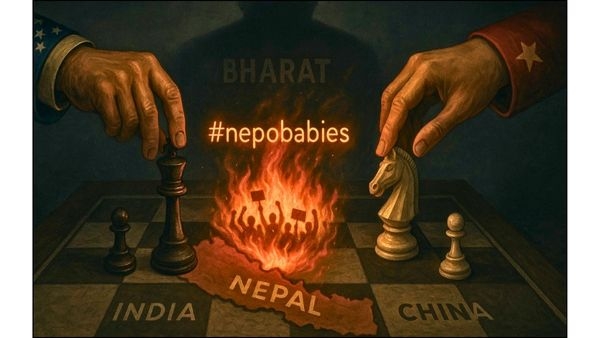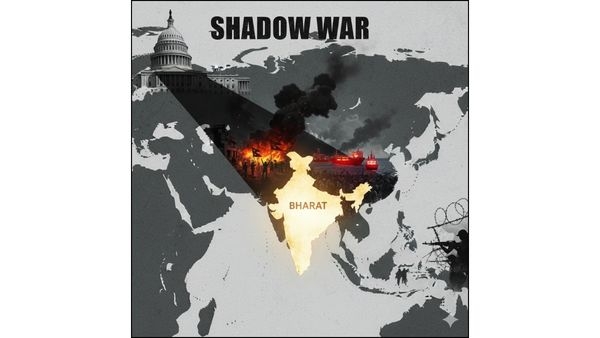Shadows of Empire: How America's Shadow War Is Fracturing South Asia, and Nepal's Wake-Up Call
Is the Nepal crisis a true uprising or a foreign-engineered colour revolution designed to destabilise South Asia’s geopolitical landscape?
Total Views |

In the shadow of the Himalayas, Nepal's streets are smouldering. What began as a Gen Z led protest against corruption and a social media ban has erupted into the deadliest unrest in decades, claiming at least 50 lives, torching the parliament, and forcing Prime Minister K P Sharma Oli to resign on 9 September 2025. Young demonstrators, fuelled by hashtags like #nepobabies, defied curfews to raze symbols of elite excess, government buildings, politicians' homes, and even the Supreme Court. The Nepal Army now patrols Kathmandu's choked avenues, while escaped prisoners roam the chaos, and the nation grapples with an interim leadership vacuum.

This is not just a spontaneous youth uprising; it is the latest chapter in a pattern of engineered instability sweeping South Asia, where the US, under the guise of promoting democracy, has systematically undermined governments that dare to chart independent paths and deny US bullying. The fingerprints of Washington are unmistakable. The National Endowment for Democracy (NED), a US funded entity often dubbed a "second CIA" for its regime change playbook, poured over $1.6 million into Nepal in 2024 alone. This cash flow was not for schools or hospitals; it funded journalist training to amplify corruption narratives and workshops for Gen Z activists in "political organising." Coincidentally, the protests exploded over exactly those themes, triggered by a modest government push for social media registration, echoing China's sovereign internet model. Although the issues were genuine, the reaction was planted. The government was pro China but the reaction planted was 100% anti Nepal. The disturbance created left a huge scar on national infrastructure and the image of the peaceful Nepalese population.
Nepal's leaders, eyeing the global success of TikTok and AliExpress, sought digital independence to foster homegrown innovation. But as an NED report warned earlier this year, such moves would be a "win for China," threatening US narrative dominance. The result? A "colour revolution" straight out of the NED's manual, leaving Nepal's fragile democracy in tatters.
This is not isolated folly; it is a calculated strategy to destabilise South Asia, encircling Bharat, the region's economic powerhouse and a counterweight to Chinese influence with a "ring of fire." From the Arabian Sea to the Bay of Bengal, the US has weaponised economic woes, student protests, and ethnic tensions to topple pro Bharat regimes, install pliable puppets, and secure military footholds. The goal is to fracture regional unity, amplify chaos, and pivot the subcontinent toward American hegemony in the Indo Pacific.
Consider Pakistan, the perennial flashpoint. Since the 2022 ousting of Prime Minister Imran Khan, often framed as an anti corruption drive but widely seen as payback for his neutral stance on Ukraine, the US has deepened ties with Islamabad's military brass. Khan's sin? Cozying up to China via the China Pakistan Economic Corridor. US Assistant Secretary of State Donald Lu, who met Pakistani opposition leaders pre coup, later visited Dhaka to push the Indo Pacific Strategy. Now, with Pakistan's economy in freefall and border skirmishes escalating, with 26 dead in a Pahalgam attack in April 2025, the stage is set for another crisis. Declassified US intelligence from the 1990s already flagged nuclear risks in Bharat Pakistan flare ups; today's drone incursions and ceasefire violations feel like a rehearsal for Armageddon, all while Washington sells arms to both sides.
Sri Lanka's 2022 economic implosion offers a textbook case. As debt ballooned from Belt and Road loans, US backed NGOs amplified protests against the Rajapaksa government, portraying it as corrupt and pro China. The "Aragalaya" movement, ostensibly about fuel shortages, toppled President Gotabaya Rajapaksa, paving the way for an IMF bailout laced with US strings. Colombo's strategic ports, once eyed by Beijing, now flirt with American basing rights. Analysts note how domestic fragility exacerbated by targeted media campaigns allowed external actors to recalibrate the island's foreign policy, shifting it from Bharat's orbit toward a US led "soft balancing."
Myanmar's civil war, raging since the 2021 coup, fits the mould. US sanctions and support for ethnic militias have prolonged the junta's isolation, creating a refugee crisis that spills into Bangladesh and Bharat. Washington's narrative frames it as a democracy crusade, but the real play is denying China access to the Bharatn Ocean via Kyaukpyu port. With over a million Rohingya displaced and smuggling networks thriving, the chaos weakens Bharat's northeastern flank, echoing US intelligence scenarios of "destabilising assets" in South Asia.
Bangladesh's 2024 upheaval was the most brazen. Student quotas sparked riots that ousted Sheikh Hasina, a staunch Bharatn ally, in August. Accusations flew that US regime change operations, funnelled through Lu's visits and NED grants, targeted Hasina's resistance to American basing on Saint Martin's Island. Her "disappearance" to Bharat strained ties with the interim Yunus regime, now tilting toward China and Pakistan. Hasina had warned of plots to carve a "Christian state" from Bangladesh, Myanmar, and Bharat using Kuki Chin insurgents and Western NGOs. The fallout? Heightened anti Bharat rhetoric, disrupted trade, and a "ring of fire" tightening around Delhi's "chicken neck" corridor.
These are not coincidences; they are a symphony of subversion. The US Indo Pacific Strategy, declassified in 2025, explicitly seeks to "counter Chinese influence" by keeping Bharat "preeminent" in South Asia while sowing discord to prevent any unified bloc. Arms sales surged amid Bharat Pakistan tensions in May 2025, with Washington trying to showcase itself as a mediator to extract concessions. As one Atlantic Council report notes, swing states like Nepal and Bangladesh are "strategic actors" whose fragility risks "destabilising the region's geopolitical balance." But whose balance? Not South Asia's people, dying in streets from Kathmandu to Dhaka.
Nepal's inferno demands a reckoning. The Maoist insurgency of 1996 to 2006, which killed 17,000 and birthed the republic, scarred the nation; today's "insurgency" risks reopening those wounds, with royalists and extremists hijacking the chaos. Yet amid the ashes, Bharat stands as Big Brother. As Nepal's historic partner under the 1950 Treaty of Peace and Friendship, it stands ready. New Delhi's $1.65 billion in lines of credit funds hydropower like Arun 4 (490 MW), railways like Jaynagar Kurtha, and post earthquake resilience. In June 2025, Nepal exported 40 MW to Bangladesh via Bharatn lines, the first tri nation energy pact, proving connectivity trumps confrontation.

Bharat can lead Nepal's stabilisation. It can broker talks with Gen Z leaders pushing for ex Chief Justice Sushila Karki as interim head; ramp up HICDP grants for youth jobs; and fortify the open 1,750 km border against smuggling. High level visits like Foreign Secretary Vikram Misri's in August 2024 can seal MoUs on WASH, agriculture, and judicial ties. Crucially, Bharat must shield Kathmandu from US "democracy aid" by exposing NED's meddling, much as it rejected Trump's hyphenated "Bharat South Asia" envoy in 2025. A stable Nepal, powered by Bharatn investment and shielded from foreign puppeteers, denies Washington its foothold.
South Asia's future hangs in the balance. America's shadow games have toppled kings and sparked wars, but they cannot extinguish the region's resilience. Nepal's youth, torching corruption's embers, remind us: true sovereignty is not granted by superpowers, it is actually seized. Bharat, step forward. The Himalayas await a partnership that keeps the shadows at bay.
Article by

Swati Suman
Postgraduate Student at the Department of Mass Communication and New Media, Central University of Jammu

